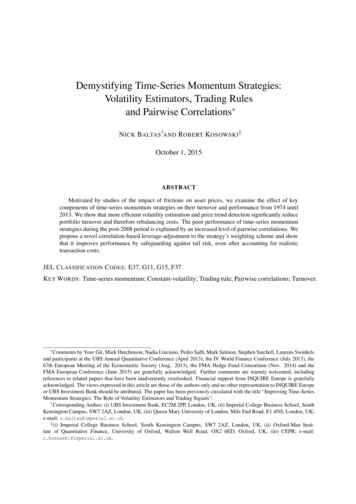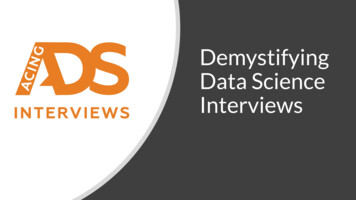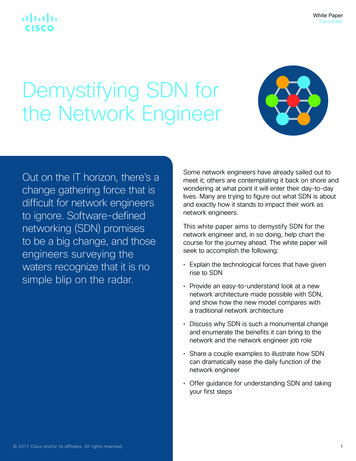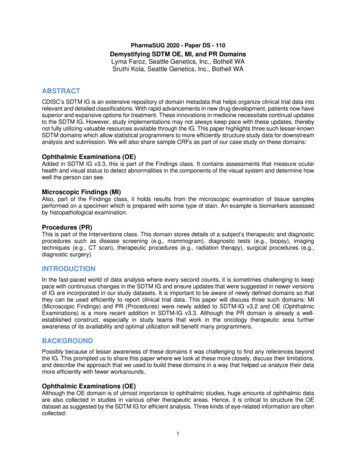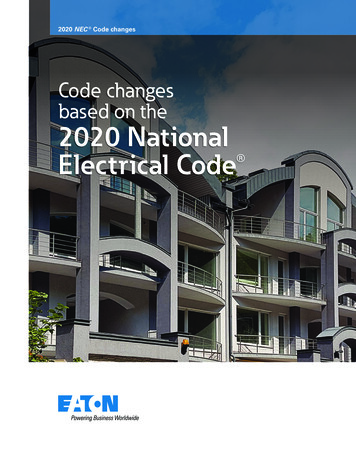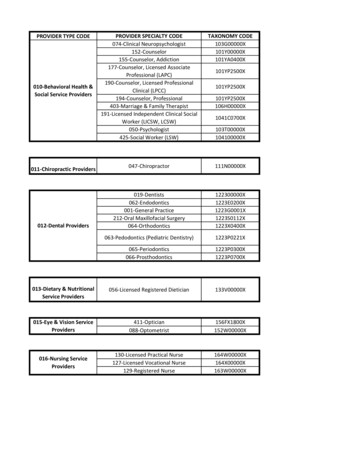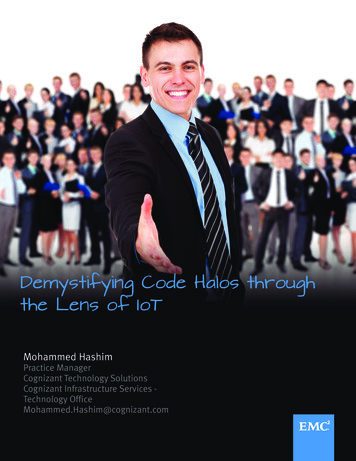
Transcription
Demystifying Code Halos throughthe Lens of IoTMohammed HashimPractice ManagerCognizant Technology SolutionsCognizant Infrastructure Services Technology OfficeMohammed.Hashim@cognizant.com
Table of ContentsIntroduction . 3IoT Impact at a Glance . 5Dynamics of Code Halos . 6Smart Four: Building Blocks . 7Enablers and Barriers.10Code Halos-based Services .11Architecting the Solution .13Code Halos Delivery Architecture .15Adoption Challenges .18IoT Information Management .20Distributed Business Intelligence for IoT-based Systems .21Risks and Mitigation .22IoT in Action in Healthcare .25Consumer Benefits of IoT .27Future and Conclusion .28Appendix A: Technical References.30Appendix B: The Crossroads Model: Winning with Code Halos .32Appendix C: Functional Reference Model of the IoT.34Appendix D: Retail Customers Experience of IoT Value .35Appendix E: Home Health Hub Reference Platform .36Appendix F: The IoT-based Smarter World .37Disclaimer: The views, processes or methodologies published in this article are those of theauthor. They do not necessarily reflect EMC Corporation’s views, processes, ormethodologies.2015 EMC Proven Professional Knowledge Sharing2
IntroductionThe genesis of ‘Code Haloed Internet of Things (IoT)’ came about when all smart things ofone or another began communicating with each other for various needs, through a versatileWeb platform over the Net, enabling wise and dynamic decision making.Code Halos Paradigm: The 'halo' refers to data that accumulates around people, devices,and organizations that is robust, powerful, and continually growing. The halos contain the‘code’ that companies, brands, employers, and partners can use to enhance theirunderstanding of people or objects in depth1.Smart sensors, actuators, and machine-to-machine (M2M) communications are continuouslyevolving in terms of intelligent sensing, user requests mapping, dynamic computing, multichannel communicating and autonomics-based execution. As we become a smarter planet,computers will instantly live in all things. Beyond our normal gadgets at work and home, theywould simply be embedded in our everyday objects like appliances, smart wear, tools,vehicles, and so on whether static or moving.IoT is primarily a network of intelligent devices and network(s) that communicate withouthuman interaction using IP connectivity. The larger IoT ecosystem includes intelligentminiaturized sensors, actuators, wireless networking and security systems, data -Analytics-Cloud)orientedtechnologyarchitecture, multilayered data integration across business intelligent applications, customsolutions, and services.IoT is realized when objects – physical or digital, static or moving – become equipped withnetworked intelligent sensors and actuators that monitor and detect defined state changes,process information, provide status updates, receive instructions if needed, and takeremedial actions. A Code Halo is realized when the same or a set of these IoT elementsintelligently cater to one or more individuals in a customized mode, capturing andprocessing discrete data.Code Halos through IoT play the foremost role in unwinding and rewiring ourselves in thedigital age: to make our lives simpler; stay healthier, shop wiser, travel safer, work easier,and predict events more accurately. This is an epic change leading to a smarter world filledwith smart products, homes, cities, networks, services and solutions. It cuts across thecomplex digital information maze that encompasses every business transaction and2015 EMC Proven Professional Knowledge Sharing3
personal interaction. Literally, anything and everything from spacecrafts to pencils could belinked to the Internet in one way or another. The key objective would be to execute adifferent set of actions according to their design purpose and user configurations. The mostvital component are smart sensors with capabilities such as self-adapt, self-configure, selfmaintain, self-heal, or even self-destroy.Although realizing the wide-ranging business potential in this space seems to be aherculean task today, things are changing at a rapid pace particularly with the escalatingadoption of SMAC-based architecture. In addition, applications, devices, and organizationswill need to have the detection systems and analytical capabilities to make business senseof the data flood created by the smart sensors over multipoint channels.This article discusses Code Halo-based tenets of IoT that redefine the lives and functions ofindividuals, industries, governments, and global organizations; building blocks, functionaland operational architecture; integration of IoT and SMAC; open barriers and enablers;cross-domain concepts and interrelated economic implications; upcoming trends; and amodel in action for the Healthcare industry.The article will explore the new digital business reality to design a roadmap for identifyingnewer prospects and accelerating digital transformation. The idea of striking a balancebetween the various entities of Code Halos and IoT would be helpful for CxOs, EnterpriseArchitects, Technology Solution Consultants, and even customers involved or interested inIoT-based systems concept, design, implementation, and value management.2015 EMC Proven Professional Knowledge Sharing4
IoT Impact at a Glance According to a Cisco Internet Business Solutions Group (IBSG) study in 2011, theIoT was ‘born’ sometime between 2008 and 2009. Looking to the future, Cisco IBSGpredicts there will be 25 billion devices connected to the Internet by 2015 and 50billion by 20202.So how big is the economic impact? The Wikibon research ‘Worldwide Industrial Internet Analysis & Projection, 2013’,estimates Industrial Internet technology spending at 514 billion and value deliveredat 1.3 trillion by 20203. Recent IDC research cites “Explosive growth in cloud and number of Internetconnected devices is expected to propel the Internet of Things market globally to 3.04 trillion in 2020”.4Thus, the potential of Code Halo opportunities led by IoT is gaining unprecedented tractionand is expected to drive unparalleled growth across industries. While IoT lays the foundationfor Code Halos; the technology industry would undergo a sea change in miniaturization ofsensing and detection, embedded digital processing, SMAC, and communication. Eachwould have varying levels of complexity, maturity, market adaptability, and service impactbased from one user or industry to another.Code Halos through IoT combines technology, individual, and public interests to take us tothe next giant leap in the Internet-led revolution that will change business models,technology focus, and customer experience affecting daily lives. Improving real-time or nearreal-time sensing and data processing, enabling intelligent task execution, and simplifyingcommunicationintroduces the unique value proposition of supporting almost anythinganytime, anywhere – the new digital computing paradigm.2015 EMC Proven Professional Knowledge Sharing5
Dynamics of Code Halos“Code Halos – the information that surrounds people, organizations, and devices – aretoday's digital fuel. Every click, swipe, and view, every interaction and transaction generatesa halo of code – a "virtual self" – that's robust, powerful, and rich with meaning and insight.Code Halos are a given in our personal lives; however, they are increasingly vital to everyorganization's future business success.” Research conducted by Cognizant's Center forthe Future of Work reveals that organizations that create, share, and distill meaning fromCode Halos are dominating their industries.5The dynamics of Code Halos is realized in our ever-increasing daily interactions across theweb like social media, e-commerce, file sharing, smartphone apps, and other computingdevices. Moreover there are multiple layers of interdependencies between each of theseinteractions that create a unique virtual identity termed by Cognizant as Code Halos.Accordingly, it is a halo of digital information connecting people, organizations, processes,and devices. Extending the Code Halos idea to other meaningful data at the enterprise levelunravels some interesting examples: Insurance companies Allstate and Progressive andothers are using very specific driver data, collected in many cases through telematicsdevices, to create new kinds of commercial models for personal and auto insurance. Disneyhas created its MagicBand system where it has encoded user credit card information andwhat kind of things consumers are interested in; it helps users get a very personalizedtheme-park guest experience based on data and information, and it’s all encoded in awristband. In manufacturing, GE creates code halos around their jet engine with hundreds ofsensors built into the engine, generating data useful for GE and airlines. It’s lowering costs,improving safety, and efficiency, and there are many business benefits. Refer to AppendixB- The Crossroads Model for the Winning Model of Code Halos.Code Halos consecutively influences vital results and decisions when user(s) apply customBusiness Intelligence to rank, validate, and choose options based on real time or near timedata processing. The approach on Mining the Business Intelligence from IoT based Systemsis covered later in this article.2015 EMC Proven Professional Knowledge Sharing6
Smart Four: Building BlocksThe Building Blocks of this digital ecosystem can be widely described as Smart Four. Theseinclude:1. Smart Sensors: The smart sensors could be anything embedded on to objects suchas ambient light sensors, thermostat controllers in refrigerator trucks, heartmonitoring implants, biochip transponders on farm animals, electric clams in coastalwaters, automobiles with built-in sensors, wearable gadgets, and so on.2. Smart Networks: IoT is an extension of the Internet connecting millions of devices.IPv6 uses a 128-bit address allowing 2128 or approximately 3.4 1038 addresses; ormore than 7.9 1028 times more than IPv4. Hence, it would technically have sufficientunique addresses to identify devices that will be manufactured and connected to theInternet for a long time. The complexity lies in handling the data from these devices,mining useful information from them, and performing real-time decisions based onthe same. The communication technology would be based on various factors likeusage, data rate, geo-location, business applications, and so on. Thus, it could be alow power ZigBee/BLE communication to a gateway and then to the Internet ordirectly to the Internet using a GSM modem or Wi-Fi/Broadband.3. Smart SMAC Fabric: SMAC helps in the convergence of shared infrastructure,mobile accessibility, real-time analytics, and collaborative services. IoT helps inrealigning a smarter SMAC platform through advanced connectivity of devices,systems, and services that goes beyond M2M covering diverse protocols, domains,and applications. The interconnection of these smart objects would trigger eventdriven automation through the cloud component of SMAC architecture.4. Smart User Enablement: As the architecture of IoT matures and Code Halos enablesusers’ action dynamically based on events from the real time objects, events couldbe interpreted in different ways depending on the current state, programmedintelligence, calibrated actuators, and history of action. In reality, the uniqueembedded physical devices help users make smarter decisions and take actionsbased on the occurring events (real or virtual) with hardly any human interaction.2015 EMC Proven Professional Knowledge Sharing7
Figure 1: IOT Architecture Sketch6A high level architecture sketch is depicted in Figure-1.The distinct macro-trends together with the explosion of ubiquitous devices that constitutethe future of IoT are:1. Exaflood or Data deluge: Forecasts7 indicate that in the year 2015 more than 220Exabytes of data will be stored. Novel mechanisms to find, fetch, and transmit datawill be needed.2. Decrease in operating power: The energy required to operate intelligent devices willdecrease with the search for a zero level of entropy where the device or system willhave to harvest its own energy.3. Miniaturization of devices: The devices will become increasingly smaller and, withIPv6 adoption, more capable to connecting over the Internet.4. Autonomic management: The devices/systems will have self-management, selfhealing, and self-configuration capabilities.2015 EMC Proven Professional Knowledge Sharing8
IoT in action can be defined formally as ‘a network of networks which enables to identifydigital entities and physical objects whether they are inanimate (including plants) or animate(animals and human beings) – directly and without ambiguity, via standardized electronicidentification systems and wireless mobile devices, and thus make it possible to retrieve,store, transfer and process data relating to them, without discontinuity between the physicaland virtual worlds’ (Source: Benghozi, Bureau, Massit-Folléa, 2008)It offers a new dimension for innovative products and dynamic services from a users’perspective. The various supporting entities and examples that come into play whenconnecting the blocks are described in Table 1.AutomaticType ofIdentification &DigitalConnectivityIntegrationDataSystemData tegratingSignal/Info/DatStakesUnique ObjectIdentificationa retrieval fromtheenvironmentsystems forInter-data to beConnection oftransmittedSystemsfrom onelayer toanotherMatureTechnologiesThermometer,Barcodes, RFIDHygrometer,solutionsAltimeter, sticesWaves, opticalchips, Storing andAnalysing dataTransferringto trigger andata to andevent, supportfroma process, orphysical andfacilitatevirtualdecisionworldsmakingExcel, ear-FieldandCommunicationMiddleware;, Wi-FiPresentatio3D Datawarehouse,Semantic WebEPCglobalNetworkn LayerTable 1: IoT Supporting Entities2015 EMC Proven Professional Knowledge Sharing9
Enablers and BarriersThe prominent enablers of Code Halos services include: Energy: Issues such as energy harvesting and low-power chipsets are vital to thedevelopment and propagation of IoT. Intelligence: Embedded devices should have built-in intelligence capabilities such calibratedresponseexecution. Communication: Newer and smarter multi-frequency/channel/band antennas, autoswitching, integrated on-chip, and advanced M2M communication will enable thedevices to connect. Integration: Integration of smart sensors into gadgets or packaged productsthemselves will allow significant cost savings and increase the eco-friendliness.Ongoing development in information integration – schema integration, semanticmediation, and ontology merging – and more intelligent search engines would help toovercome conventional limitations of Enterprise application integration (EAI) forenterprise-wide and inter-enterprise integration.The prominent barriers of Code Halos services include: Governance: Without a central authority, it will be impossible to have a truly globalIoT. No universal numbering system currently exists. EPC Global and Ubiquitous IDare two different, non-compatible ways of identifying objects. There is a need forkeeping governance as generic as possible. One authority per field will certainly leadto overlap, confusion, and competition between standards. Interoperability Standards: The disconnect between the logical and physical worldsdue to lack of interoperability leads to structural and semantic heterogeneity.Protocols for interoperability across platforms and global standards that aresustainable, energy-efficient, security- and privacy-centered, and use compatible oridentical protocols are needed. Privacy and Security: Public acceptance of IoT will happen only when strong securitysolutions are in place. The standards must define different security features toprovide confidentiality, integrity, or availability of services. The issues related toidentity of people must be dealt with in politics and legislation.2015 EMC Proven Professional Knowledge Sharing10
Code Halos-Based ServicesCode Halos-based services would cater to industry wide segments. Prominent industriesinclude:1. Healthcare: IoT enables remote health monitoring and emergency notificationsystems. These devices can range from blood pressure and heart rate monitors toadvanced devices capable of monitoring specialized implants, such as pacemakersor advanced hearing aids. Code Halos enables specialized sensors calibrated forindividuals to monitor the health and general well-being of senior citizens, while alsoensuring that proper treatment is being administered, assisting patients recuperatingthrough therapy, and so on.2. Manufacturing, Logistics, and Retail: Integrated network control and management ofmanufacturing equipment, asset and situation management, or manufacturingprocess control bring IoT within the realm on industrial applications and smartmanufacturing, optimization of supply chain management (SCM), and dynamicproduct lifecycle management. Major advantages in this area are improvement inproduct authentication and anti-counterfeiting, next-generation industrial automationand SCM, inventory management, tracking, and remote maintenance and support.3. Energy and Utilities: Integration of sensing and actuation systems through IoT wouldoptimize energy consumption as a whole. Examples include Smart electricity andwater transmission grids, real-time monitoring of sewage systems, and efficientenergy and water consumption at residences linked to the grid.4. Intelligent Transportation: IoT can assist in integration of 3Cs (Communications,Control, and Command) across various transportation systems and sub-systems andallied services. This is realized through the use of built-in transport sensor networks,telematics, GPS, and wireless networks for smart vehicles that woul
improving safety, and efficiency, and there are many business benefits. Refer to Appendix B- The Crossroads Model for the Winning Model of Code Halos. Code Halos consecutively influences vital results and decisions when user(s) apply custom Business Intelligence to rank, validate, and choose
